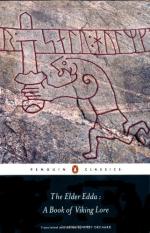|
This section contains 3,272 words (approx. 9 pages at 400 words per page) |

|
Lotte Motz argues that the pattern between Eskimo and Norse tradition is similar, which leads to understanding the "similarity of linguistic dynamics."
In his treatise on poetry, the so-called Edda Snorra, Snorri (1949:244) states that the human mind is periphrased in skaldic speech as 'the wind of trollwomen' without offering an explanation for the unexpected image. We do find such kennings as . . . 'the storm of Járnsaxa (a giantess) in the meaning of 'courage', or Herkju stormr'Herkja's (a giantess') storm' in the meaning 'mind'.
Snorri's puzzling statement has given rise to some scholarly interpretations. In his book on magic practices Dag Strömbäck assumed that the noun hugr of Snorri's sentence (Huginn skal svá kenna at kalla vind troll-kvenna) relates to the force named hugr, which lives in men, and which may, according to Norse belief, detach itself and wander forth, corporeally...
|
This section contains 3,272 words (approx. 9 pages at 400 words per page) |

|




